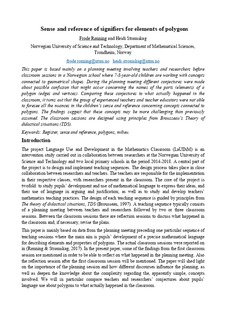| dc.contributor.author | Rønning, Frode | |
| dc.contributor.author | Strømskag, Heidi | |
| dc.date.accessioned | 2020-01-28T12:35:01Z | |
| dc.date.available | 2020-01-28T12:35:01Z | |
| dc.date.created | 2020-01-13T10:52:53Z | |
| dc.date.issued | 2019 | |
| dc.identifier.isbn | 978-1-873769-73-7 | |
| dc.identifier.uri | http://hdl.handle.net/11250/2638343 | |
| dc.description.abstract | This paper is based mainly on a planning meeting involving teachers and researchers before classroom sessions in a Norwegian school where 7-8-year-old children are working with concepts connected to geometrical shapes. During the planning meeting different conjectures were made about possible confusion that might occur concerning the names of the parts (elements) of a polygon (edges and vertices). Comparing these conjectures to what actually happened in the classroom, it turns out that the group of experienced teachers and teacher educators were not able to foresee all the nuances in the children’s sense and reference concerning concepts connected to polygons. The findings suggest that these concepts may be more challenging than previously assumed. The classroom sessions are designed using principles from Brousseau’s Theory of didactical situations (TDS). | nb_NO |
| dc.language.iso | eng | nb_NO |
| dc.publisher | European Society for Research in Mathematics Education | nb_NO |
| dc.relation.ispartof | Proceedings of the Eleventh Congress of the European Society for Research in Mathematics Education | |
| dc.title | Sense and reference of signifiers for elements of polygons | nb_NO |
| dc.type | Chapter | nb_NO |
| dc.description.version | acceptedVersion | nb_NO |
| dc.identifier.cristin | 1771194 | |
| dc.relation.project | Norges forskningsråd: 238041 | nb_NO |
| dc.description.localcode | Published by European Society for Research in Mathematics Education. Copyright the authors 2019. | nb_NO |
| cristin.unitcode | 194,63,15,0 | |
| cristin.unitname | Institutt for matematiske fag | |
| cristin.ispublished | false | |
| cristin.fulltext | postprint | |
